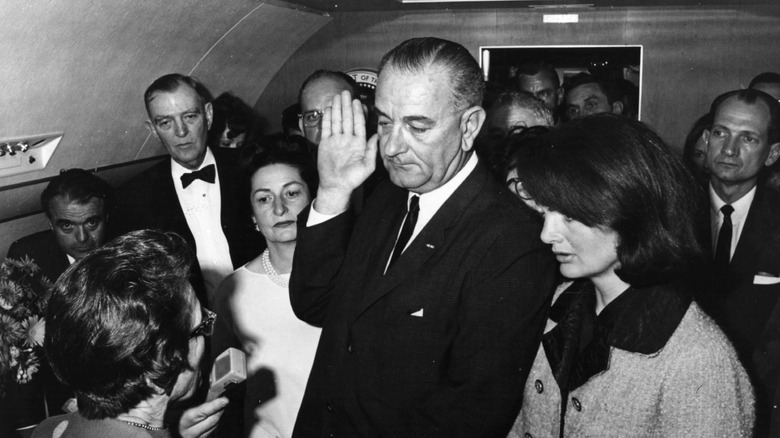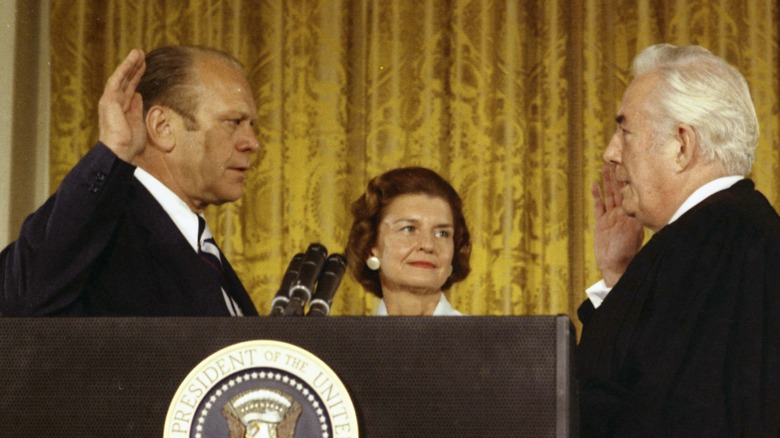The Truth About What Happens If Joe Biden Dies In Office
America knew what it was taking on when it chose Joe Biden to be the 46th president of the United States. While Biden is generally in good health, at 78, Biden is the oldest president the country has had. During his last medical check, which took place before he took office, his physician, Kevin O'Connor of George Washington University, described the then-president-elect as a "healthy, vigorous, 77-year-old male, who is fit to successfully execute the duties of the Presidency to include those as Chief Executive, Head of State and Commander in Chief" (via NBC). Further, White House press secretary Jen Psaki says that the president "is so healthy, she sometimes has a hard time keeping up with him" (via Fox News).
But this is not to say that Biden hasn't had health scares — he's already survived two brain aneurysms which took place in the late 1980s, and he's on different types of medication such as blood thinners, as well as tablets to help with minor problems such as acid reflux, cholesterol, and allergies. Most recently he worried fans when he nearly took a tumble as he was boarding Air Force One.
So while we aren't keen on playing the "what if" game, particularly if it involves the death of a president, there is something of a need to talk about what happens in the event that Joe Biden dies in office — which is something we had to do when former President Donald Trump came down with COVID-19 before the November elections in 2020 (via The Intelligencer).
The Presidential Succession Act ensures an orderly transfer of power
First of all, it might make you feel better to know that the country has laws that guarantee the continuity of government, which keeps a vacancy from coming up in the event that the president dies while in office. The Presidential Succession Act has gone through some changes from when the act was first created in 1792, and amended in 1886, and then again in 1947. The changes had to do with the positions of both the Senate president pro tempore and the speaker of the House within the line of succession (via the U.S. Senate).
So in the event that President Joe Biden were to die in office, the Succession Act dictates that he would be succeeded by Vice President Kamala Harris, followed by the speaker of the House — who at this time is Nancy Pelosi. After Pelosi, it would be the Senate president, Patrick Leahy, and then Secretary of State Anthony Blinken. The last seat in the 16-person line of succession is the Secretary of Homeland Security Alejandro Mayorkas.
The Presidential Succession Act has been used several times before
History is full of examples that show that the Presidential Succession Act works; while the United States has, by and large, been a peaceful country, it has had some experience in losing a sitting president. Of the 46 heads of government we've had so far, eight have died in office. Four had been ill: William Henry Harrison, who holds the record for the shortest presidency, died of pneumonia after he caught a cold (via The White House); Zachary Taylor had cholera (via the Miller Center); Warren Harding, whose death by heart attack generated numerous conspiracy theories (via PBS); and Franklin D. Roosevelt, who died of congestive heart failure, which he developed before his fourth and final term (via The Washington Post).
The rest — Abraham Lincoln, William McKinley, James Garfield, and John F. Kennedy — were assassinated, and all four were succeeded by the vice presidents they had been elected with (via History Extra).
The end of Richard Nixon's term set a precedent
But history also shows us that there can be exceptions to the rule, and we saw that in the early 1970s, as the term of Richard M. Nixon was wrapping up. Many people might recall that Gerald R. Ford succeeded Nixon after he resigned in August 1974, but few will remember that Ford was not elected as Nixon's vice president, and that he was, in fact, House minority leader (via the National Constitution Center). Ford was a compromise candidate who was chosen because he was expected to pass a Senate confirmation process with few problems, and both the speaker and the Senate president pro tempore were Democrat (via the U.S. Senate).
History points out that Ford is the first president who became commander in chief by appointment, because Nixon had nominated Ford, who was a Republican as Nixon was, to replace Vice President Spiro Agnew in November 1973. Agnew had to resign over charges of tax evasion and corruption. (Fun fact: Ford later pardoned Nixon for anything illegal he did in office).



